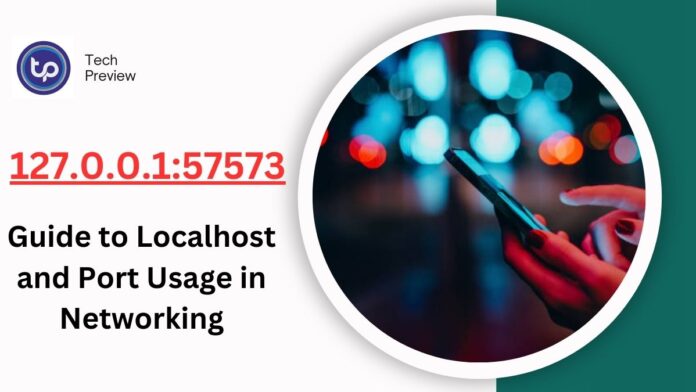In networking world, understanding how devices communicate within a network is important. One of the most fundamental yet often misunderstood concepts is the loopback address, mainly 127.0.0.1, paired with port numbers like 57573.
This combination, often seen in development environments and various networking tasks, is essential in local networking.
In this comprehensive guide, we’ll dive deep into what 127.0.0.1:57573 represents why it’s used, how it functions, and the best practices for using it effectively in your network setups.
What Is 127.0.0.1:57573?
At its core, 127.0.0.1 is the loopback address, which is genrally referred to as “localhost.” This address allows a device to communicate with itself, essentially creating a direct connection within the system, bypassing any external network interfaces.
The 127.0.0.1 IP addresses are standardized across all devices that use the IPv4 protocol and reserved for loopback purposes. They play an important role in testing and development, allowing software to operate in an isolated environment without needing to connect to a broader network.
The port number, such as 57573, is a communication endpoint. Ports are numerical identifiers in networking that allow different services or applications on the same device to be distinguished and accessed individually.
Port 57573 is not assigned to any specific service by default, making it a used port for local applications, mainly in the development and testing phases.
To know more in detailed, click here.
The Importance of 127.0.0.1 in Local Networking
The 127.0.0.1 address is often seen as the “home” of any device. It is a fundamental part of the networking stack and is used in a number of scenarios:
- Development and Testing: Developers use
127.0.0.1to test applications locally without exposing them to external networks. This isolation helps debug and test new features securely. - Security and Performance: Since the loopback address doesn’t require routing through external devices, it ensures high performance and reduces security risks associated with external network exposure.
- Configuration and Setup: System administrators use
127.0.0.1during the setup of new servers or services. It has a sandbox environment where configurations can be tested before deploying to a live network.
How Does 127.0.0.1:57573 Work?
When you connect to 127.0.0.1:57573, your device is communicating with itself through the loopback network interface. Here’s a breakdown of how it works:
- Loopback Interface: The loopback interface is a virtual network interface that a device uses to send network traffic to itself. This interface is represented by
127.0.0.1in IPv4 (or::1in IPv6). It is hardwired into the device’s networking stack and does not involve any physical networking hardware. - Port Binding: When an application starts and listens on
127.0.0.1:57573, it binds to port57573on the loopback interface. The application will accept connections directed to this specific port at the local host address. Binding to the loopback interface keeps the service local, preventing external access. - Data Flow: Data sent to
127.0.0.1:57573does not leave the device. It is immediately redirected back internally, providing rapid and secure communication. This is particularly useful for web servers, APIs, and other applications that need to run locally.
Common Uses of 127.0.0.1:57573
Understanding the practical uses of 127.0.0.1:57573 can help clarify its significance in everyday networking and software development. Here are some of the most common scenarios:
- Web Development: Web developers frequently use
127.0.0.1With various ports to host local instances of websites, APIs, or web services. For example, when testing a new web application, a developer might run a server on127.0.0.1:57573to check functionality without making the site publicly accessible. - Database Connectivity: Developers often connect to databases hosted
127.0.0.1for testing purposes. This ensures that database queries and operations are performed in a secure, local environment. - Application Debugging: Debugging tools and environments are frequently used
127.0.0.1to capture data and analyze application performance without affecting production services. - Service Configuration: System administrators use the loopback address to configure services, run scripts, or perform routine maintenance tasks on servers, ensuring these operations do not interfere with the live network.
Security Implications
Using 127.0.0.1 is generally considered safe because it limits access to the local machine. However, there are security considerations to keep in mind:
- Access Control: Since
127.0.0.1restricts connections to local services only, it inherently blocks external access. This isolation is a powerful security feature, as it prevents unauthorized access from outside the device. However, misconfigurations can sometimes inadvertently expose these services, especially if ports are improperly forwarded or firewall rules are not correctly set. - Network Isolation: By using
127.0.0.1, applications can remain isolated from the network, reducing the attack surface. This is particularly useful in development environments where applications are often incomplete or vulnerable. - Firewall and Network Policies: Localhost traffic often bypasses firewalls and network security policies designed for external traffic. While this is generally advantageous for development, it means that malicious software on the same device could exploit local services if proper security measures aren’t taken.
Troubleshooting Common Issues
While working with 127.0.0.1:57573, users may encounter various issues. Here are some common problems and their solutions:
- Port Conflicts: If another application is already using port
57573, you’ll encounter an error when trying to bind a new service to this port. To resolve this, either stop the conflicting service or choose a different port number for your application. - Access Denied Errors: These errors can occur if the service does not have the necessary permissions to bind to the port or if there are firewall rules blocking the connection. Ensuring that the service runs with the appropriate permissions and adjusting firewall settings can resolve these issues.
- Service Not Responding: If the service bound to
127.0.0.1:57573is not responding, it may be due to the application crashing, being misconfigured, or encountering an internal error. Reviewing application logs, checking service status, and verifying configurations can help identify and fix the problem.
Best Practices for Using 127.0.0.1:57573
To make the most of 127.0.0.1:57573 it while maintaining security and efficiency, consider these best practices:
- Keep Services Local: Only bind services to
127.0.0.1if they do not need to be accessed externally. This prevents unnecessary exposure to the wider network. - Use Unique Ports: Avoid using common or well-known ports unless necessary. Choosing unique or randomly assigned ports for local services can help reduce the chance of port conflicts and enhance security by obscurity.
- Regularly Update and Patch: Ensure that all applications and services running on
127.0.0.1:57573are up-to-date with the latest security patches and updates. This helps protect against vulnerabilities that could be exploited, even within a local environment. - Monitor Local Services: Implement monitoring tools that track the performance and health of local services. While these services are not exposed to external threats, they can still fail or behave unexpectedly, affecting your development or testing environment.
The Future of Local Networking and 127.0.0.1
As networking technology evolves, the role of 127.0.0.1 remains important, mainly in development and testing scenarios. The emergence of containerization, microservices, and virtual environments continues to leverage the loopback interface to create isolated, secure, and efficient development environments.
- Containers and Virtual Machines: Tools like Docker and virtual machines often use
127.0.0.1within their respective environments to manage services internally, without exposing them to the host network. This keeps testing isolated and safe from external interference. - Microservices Architecture: In microservices, multiple small services often communicate with each other over localhost. Using
127.0.0.1helps simplify this communication and ensures that it remains confined within the system, reducing latency and enhancing security. - Emerging Protocols: As IPv6 adoption grows,
127.0.0.1is complemented by::1in IPv6, serving the same purpose for local networking. The principles remain consistent, providing a reliable method for devices to communicate internally.
Conclusion
The 127.0.0.1:57573 address and port combination might seem like just another technical detail in the vast world of networking, but its role is pivotal in creating secure, isolated environments for development, testing, and configuration. By understanding how 127.0.0.1 functions, along with best practices for its use, developers and network administrators can harness its full potential while maintaining robust security measures.
Whether you’re developing a new web application, configuring services on a server, or simply exploring the basics of networking, knowing how to use effectively 127.0.0.1 and its associated ports can significantly enhance your ability to manage and troubleshoot local network communications.
RELATED ARTICLES
- How can Mac Users Split OLM Files by Size?
- How Templates Help Businesses Deliver Quality on a Budget – Cost-effective Solutions
- Revolutionary Robotic Exoskeleton Can Teach Pianists to Play at Lightning Speed
- Top 5G Smartphones in India: Best Devices for Speed and Connectivity
- This Tiny Robot Can Flip, Hover, and Loop for 15 Minutes Without Breaking








